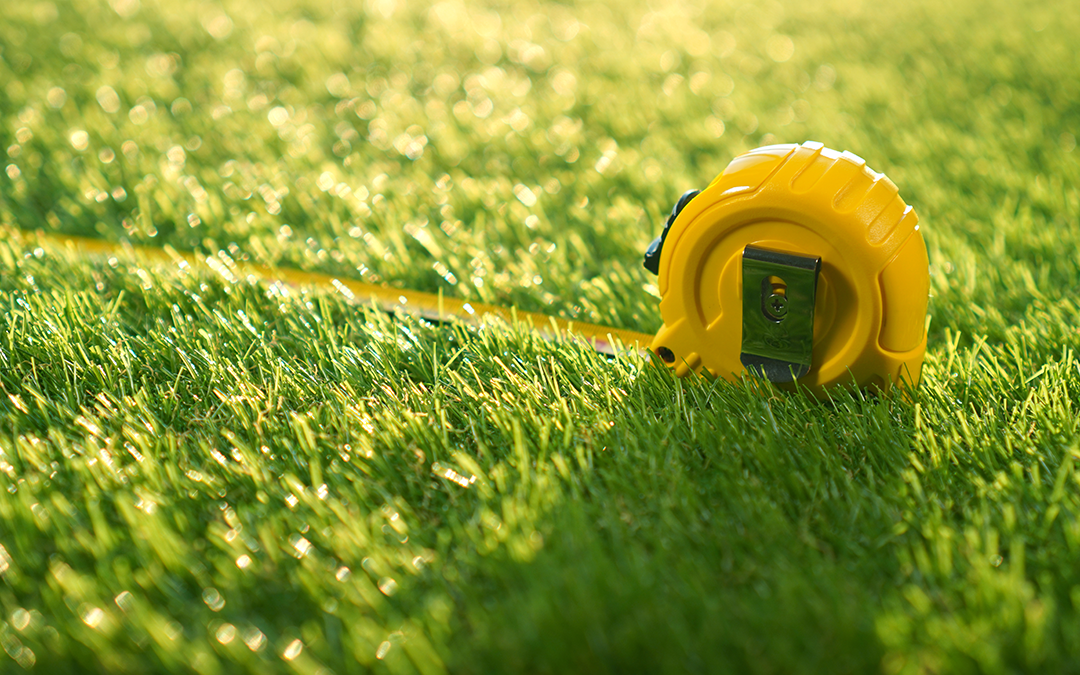Measuring sod before starting your project will save you time, money, and help avoid the guessing game that isn’t always accurate. Whether you are an experienced landscaper or a homeowner starting your own DIY yard project, finding the correct amount of sod for your project is a necessary step to take. In this blog, you will learn step by step how much sod you actually need for your project and some shortcuts that will help you save time!
What is Sod, and What is Sod Used For?
Sod consists of grass and a little portion of the soil beneath it, which is held together by the root system or, in certain situations, a thin layer of biodegradable material.
Around the world, sod is commonly used for lawns, golf courses, and sports stadiums. It is sold to landscapers, home builders, and homeowners who use it to swiftly develop a lawn and reduce soil erosion in residential construction. Sod is a faster alternative to re-growing a lawn from seed and can be used to repair a small area of lawn, golf course, or athletic field that has died. Sod can also help with flood protection by improving cooling, enhancing air and water quality, and draining water.
How to Measure How Much Sod You Need
Step 1:
Select a flat, clear area in your yard that will be suitable to lay sod. Make sure the site is clean and level. If there are weeds, make sure to spray them with weed killer and wait two weeks before pulling them out, for more about killing weeds check out this blog. Mark off reference lines using spray paint or by stretching string between stakes along the width and length of the area (you will need these strong lines again for Step 4).
Step 2:
To determine the quantity of sod you will need for your project you must find the surface area of your lawn. You can do this with a tape measure or “wheel”.
Calculate how much area you can cover with your number of pallets. Measure the length and width of the area using a tape measure, then multiply your measurements together to find out how many square feet you have in the space.
Step 3:
Divide that number by 9 to get your pallet quantity. For example, if you have 1,000 square feet in your space, you will need 111 pallets to cover the area. We suggest adding 2% or 3% extra for installation losses when fitting into odd-shaped areas. It’s easier to have a little leftover than having to arrange to get more sod.
Step 4:
Measure down 6 inches from the top edge of your string lines and make reference marks using crayon or chalk at every 12 inches along the length of the space. These reference marks will be used when placing each pallet in position on-site.
Step 5:
Make sure you have your pallets in the appropriate formation before laying down any sod. This will speed up the process and ensure that all of your sod will come out even. Use a shovel to cut through one side of each pallet, making all cuts identical so they fit together easily. Stack them in this formation when you take them to your site.

Step 6:
Take the pallets out of their stacks, being careful not to mix up or shuffle the pieces around too much so that you keep all of the plates together with the bottom side facing down. Then, follow your reference marks on your string line and begin placing the pallets on-site so that the top of each piece is flush against your reference lines.
Step 7:
Once all of the pieces are laid out, you can use a rubber mallet to attach them together by pounding pallet nails through the connecting edges. You will need at least two nails per connection. Then, use a sod cutter to cut through the sod along each pallet edge, but do not detach it yet.
Step 8:
Now you are ready for installation! Use a shovel to dig out 6-inch deep by 6-inch wide trenches along the edges of your pallets. Lift up any corner pieces with a spade to make sure that they are properly attached.
Step 9:
Now, you can cut the sod into 12-inch by 12-inch pieces along your reference lines and lay them in the trenches for re-installation. Be sure to stagger each row so that there is an open row on either side of the trench. Pound 2-inch galvanized nails into each side of the pieces to attach them to the ground.

Step 10:
Once all of your pieces are attached, you can use a shovel to flatten down the soil along the top edges of your pallets, filling in any small gaps between sod pieces and making sure that the surface is even. Then, water your yard thoroughly to the point where it feels spongy underfoot, and let it settle for about one week but always ask the professional you bought the sod from for their recommendation for that type of sod.
Now you can enjoy your new lawn!

Sod Tips
- It’s always best to check with a professional first before picking out sod for your project. Sod rooting in your grass can depend on several factors including your soil, climate, and time of year.
- If you are installing sod on your own, start the installation immediately after sod arrival to prevent the sod from drying out.
- Avoid heavy traffic on your new lawn for the first few weeks.
We hope this blog post helps you learn how to measure for sod and how to install sod for your next project. If you follow this step-by-step guide, you’ll have a beautifully landscaped yard with fresh sod in no time!
SOD CALCULATOR
By providing us with a little bit of information about your project and preferences, we can provide you with a quick estimate! Fill out the form, or call us if you aren’t sure of some of the details.

